Agile vs Scrum: Choosing the Right Methodology for Your Project
Choosing the right methodology can make or break your success.
As organizations strive for greater efficiency and adaptability, the debate between Agile and Scrum methodologies has taken center stage.
But what exactly is Agile vs Scrum, and how do they differ?
Key Highlights
- Key differences between Agile and Scrum
- How to choose between them for effective project management
- Principles, practices, and roles associated with each
- Implementation challenges and solutions
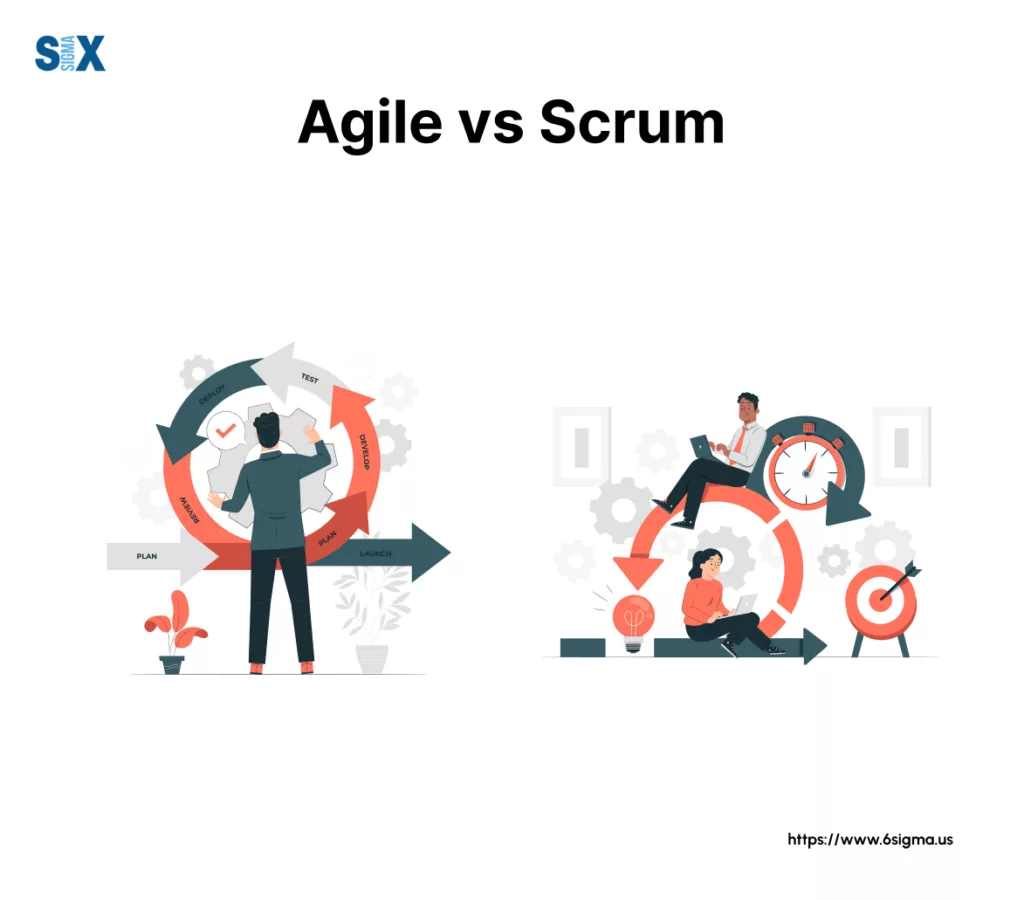
Understanding Agile
The agile vs scrum methodology debate begins with understanding their origins.
Agile emerged in 2001 when 17 software developers created the Agile Manifesto, a response to the limitations of traditional project management in software development.
This pivotal moment marked the beginning of what we now know as agile methodology vs scrum and other project management approaches.
Traditional methods often failed in software development due to their rigidity and inability to adapt to rapidly changing requirements.
For example, the infamous FBI Virtual Case File project, which wasted $170 million over five years, highlighted the need for a more flexible approach. This failure catalyzed the adoption of agile methodologies.
Today, the impact of agile is undeniable. According to the 15th State of Agile Report, 94% of organizations practice agile, demonstrating its widespread acceptance across industries.
Core Principles of Agile
To truly grasp what is agile vs scrum, we must understand agile’s foundational principles.
The Agile Manifesto outlines four core values:
- Individuals and interactions over processes and tools
- Working software over comprehensive documentation
- Customer collaboration over contract negotiation
- Responding to change over following a plan
These values are supported by 12 principles that guide agile project management. For instance, one principle states, “Welcome changing requirements, even late in development”. This flexibility is a key agile vs scrum difference, as scrum provides a more structured framework within the agile philosophy.
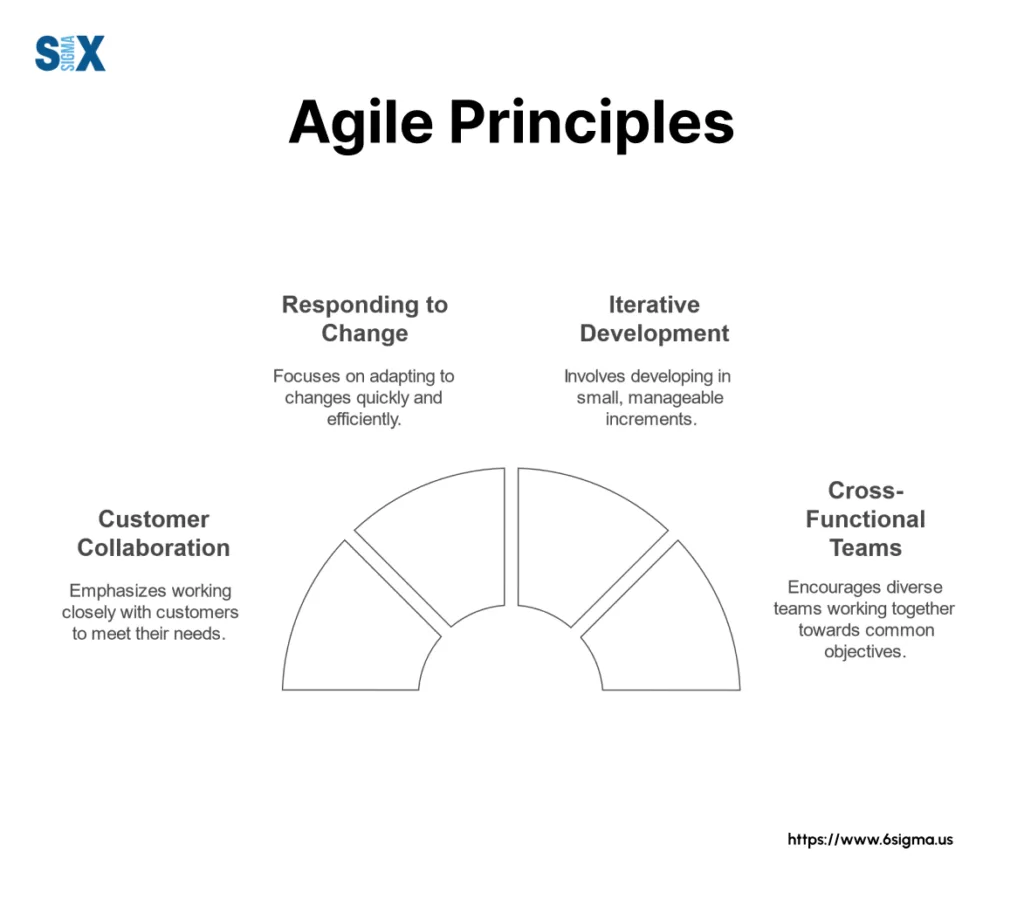
Agile in Non-Software Industries
While the agile vs scrum project management discussion often centers on software development, agile’s adaptability has led to its adoption across various sectors.
This versatility is a crucial factor when considering agile vs scrum certification options.
Case Studies:
- Marketing: Spotify uses agile methods to quickly adapt its marketing strategies based on real-time data and user feedback.
- Manufacturing: John Deere implemented agile practices to reduce product development time by 75%.
- Education: Ashford University adopted agile methodologies to improve curriculum development and student outcomes.
These examples demonstrate that the principles behind agile vs scrum methodology can be applied beyond software development, offering flexibility and efficiency in diverse fields.
Understanding the philosophy behind agile is crucial when comparing scrum vs agile development or evaluating scrum vs agile methodology.
While scrum is a specific framework within the agile umbrella, agile itself is a broader philosophy that can be adapted to various contexts and industries.
By grasping these foundational concepts, you’re better equipped to navigate the nuances of agile vs scrum project management and make informed decisions about which approach best suits your organization’s needs.
Combine Lean principles with your project management skills with our Lean Six Sigma Yellow Belt
Scrum: An Agile Framework in Action
In agile vs scrum project management, Scrum stands out as a specific framework within the broader Agile philosophy.
Originating in the early 1990s, Scrum was developed by Jeff Sutherland and Ken Schwaber as a way to manage complex product development.
When considering what is agile vs scrum, it’s crucial to understand that Scrum is a structured implementation of Agile principles.
Scrum is characterized by its iterative and incremental approach, breaking work into short cycles called sprints.
This structure is a key agile vs scrum difference, as Scrum provides a more defined process within the flexible Agile mindset.
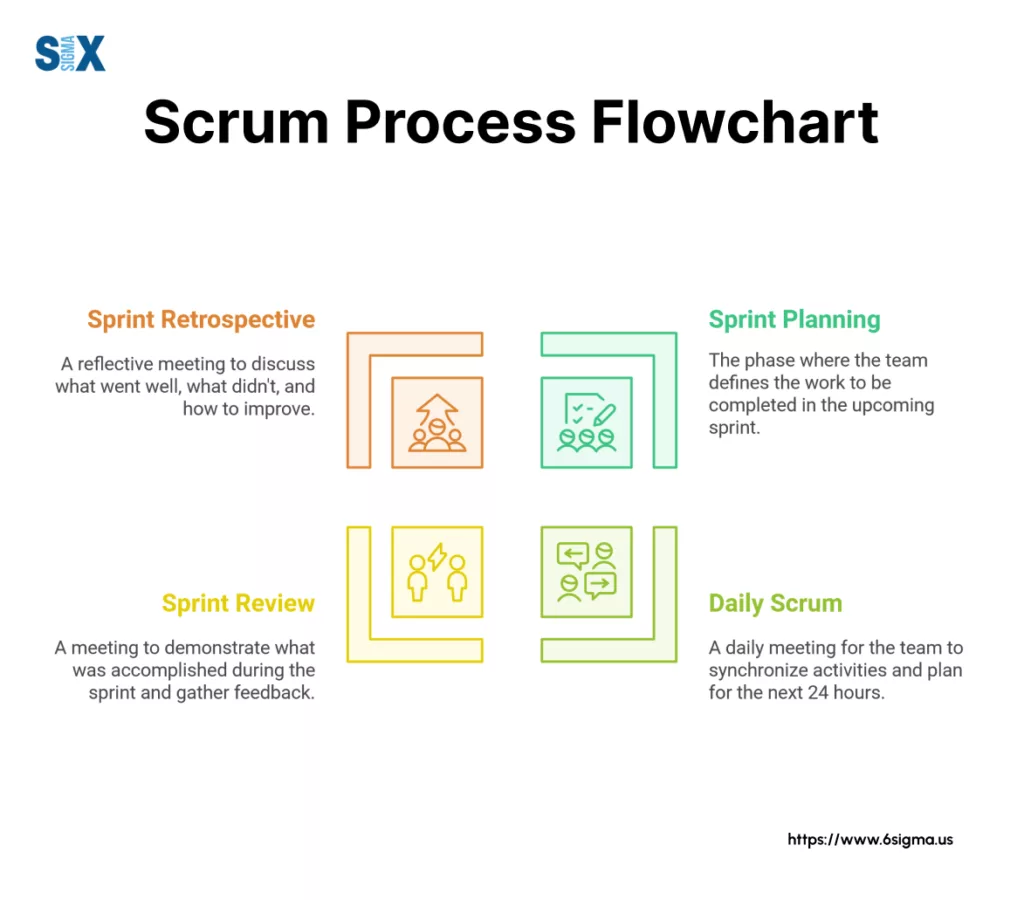
Scrum Roles and Responsibilities
When comparing scrum vs agile development, one notable distinction is Scrum’s clearly defined roles.
These roles are essential to understanding the agile vs scrum difference:
- Product Owner: Responsible for maximizing the value of the product and the work of the Development Team.
- Scrum Master: Ensures the Scrum process is understood and followed, acting as a servant-leader for the Scrum Team.
- Development Team: Cross-functional group responsible for delivering potentially shippable increments of the product.
A day in the life of a Scrum Master might involve facilitating Daily Scrum meetings, coaching team members, and removing impediments to the team’s progress.
This role is unique to Scrum and doesn’t have a direct equivalent in other agile methodologies.
According to the 2021 State of Agile Report, the average Scrum team size is 7-9 members, balancing diversity of skills with ease of communication.
Scrum Events and Artifacts
The structure of Scrum events and artifacts further illuminates the scrum vs agile methodology comparison:
- Sprints: Time-boxed iterations, typically 1-4 weeks long
- Daily Scrum: 15-minute daily synchronization meeting
- Sprint Review: Demonstration of work completed during the sprint
- Sprint Retrospective: Team reflection on process improvement
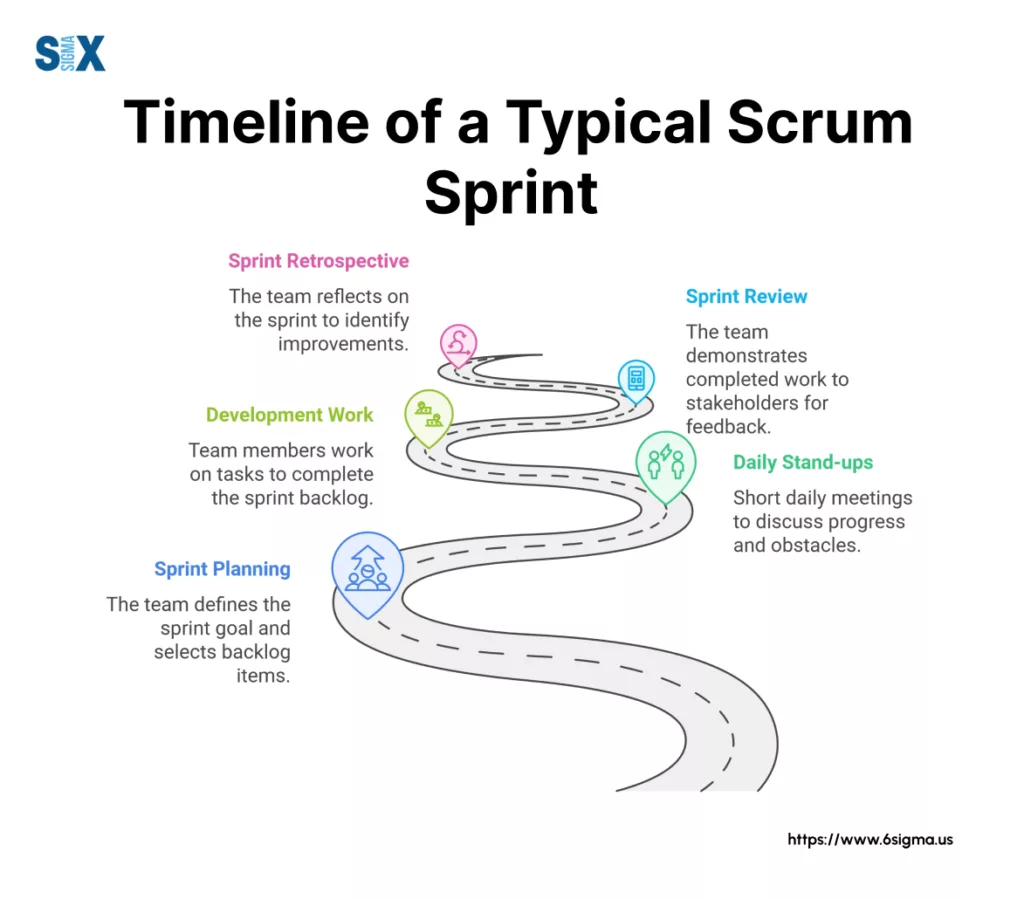
Scrum artifacts include the Product Backlog, Sprint Backlog, and Increment.
These tools help maintain transparency and provide opportunities for inspection and adaptation, aligning with core Agile principles while providing more structure.
To ensure successful Sprint Planning, use this checklist:
- Product Backlog is refined and prioritized
- Team capacity is known
- Sprint Goal is defined
- Previous Sprint Retrospective actions are reviewed
Understanding these Scrum components is crucial when considering agile vs scrum certification options, as Scrum certifications often focus on mastering these specific practices.
In the debate of agile methodology vs scrum, it’s important to recognize that Scrum is a framework within Agile. While all Scrum is Agile, not all Agile is Scrum.
This distinction is key when evaluating which approach best suits your project management needs.
By grasping these Scrum concepts, you’re better equipped to navigate the nuances of scrum vs agile and make informed decisions about implementing these methodologies in your organization.
Agile vs Scrum: Key Differences and Similarities
Understanding the agile vs scrum difference is crucial for making informed decisions about methodology adoption.
While both approaches share common roots, their implementation and focus can vary significantly.
Philosophical Differences b/w Agile vs Scrum
At its core, the agile vs scrum project management debate centers on scope and application.
Agile is a mindset, a set of values and principles that guide project management and software development.
Scrum, on the other hand, is a specific framework that falls under the Agile umbrella, providing a structured approach to implementing Agile principles.
For example, when a company transitions from traditional methodologies to Agile/Scrum, they often start by adopting Agile principles across the organization before implementing Scrum at the team level.
This transition requires a significant mindset shift.
Practical Implementations b/w Agile vs Scrum
When comparing agile vs scrum methodology in practice, we see distinct differences in structure and flexibility.
Agile allows for various implementations, while Scrum provides a more defined framework.
Here’s a comparison table highlighting key agile vs scrum differences:
| Aspect | Agile | Scrum |
|---|---|---|
| Nature | Philosophical approach | Specific framework |
| Flexibility | Highly flexible | Structured with defined roles and events |
| Team Structure | Self-organizing teams | Defined roles (Product Owner, Scrum Master, Development Team) |
| Project Planning | Continuous planning | Sprint planning |
| Delivery Cadence | Continuous delivery | Sprint-based delivery |
| Leadership | Collaborative leadership | Servant leadership (Scrum Master) |
When to Use Agile vs Scrum
Choosing between scrum vs agile development often depends on project types, team dynamics, and organizational culture.
Agile methodologies, in general, work well for projects with evolving requirements and a need for continuous adaptation.
Scrum, as a specific agile framework, is particularly effective for complex projects that benefit from regular feedback and incremental delivery.
Understanding these nuances is crucial when considering agile vs scrum certification options.
While Agile certifications often focus on broader principles and various methodologies, Scrum certifications delve into the specific practices and roles within the Scrum framework.
In conclusion, while Scrum is a type of Agile methodology, not all Agile approaches are Scrum.
The choice between agile and scrum depends on your specific project needs, team structure, and organizational goals.
By understanding the key differences and similarities between agile vs scrum, you can make an informed decision on which approach will best drive your project’s success.
Implementing Agile vs Scrum: Challenges and Solutions
Organizations often encounter obstacles in adoption and implementation.
Understanding these challenges and having strategies to overcome them is crucial for a successful transition to either methodology.
Common Obstacles in Adoption
When implementing agile methodology vs scrum, organizations frequently face similar hurdles:
- Resistance to change: Employees accustomed to traditional methods may struggle with the shift to agile or scrum practices.
- Lack of management support: Without buy-in from leadership, agile vs scrum initiatives can falter.
- Improper implementation: Misunderstanding the principles of agile vs scrum can lead to ineffective execution.
According to the 14th Annual State of Agile Report, the top challenges in adopting and scaling agile methodologies include:
- Organizational culture at odds with agile values (48%)
- General organizational resistance to change (44%)
- Inadequate management support and sponsorship (42%)
To assess your organization’s readiness for agile or scrum adoption, take our quick self-assessment quiz:
Strategies for Successful Implementation of Agile vs Scrum
Overcoming these obstacles requires a strategic approach to implementing agile vs scrum methodologies:
- Training: Invest in comprehensive agile vs scrum certification programs for team members and leadership.
- Cultural shift: Foster an environment that embraces agile principles, emphasizing collaboration and adaptability.
- Incremental adoption: Start with pilot projects to demonstrate value before scaling across the organization.
To guide your organization’s journey in adopting agile vs scrum project management approaches, consider this roadmap:
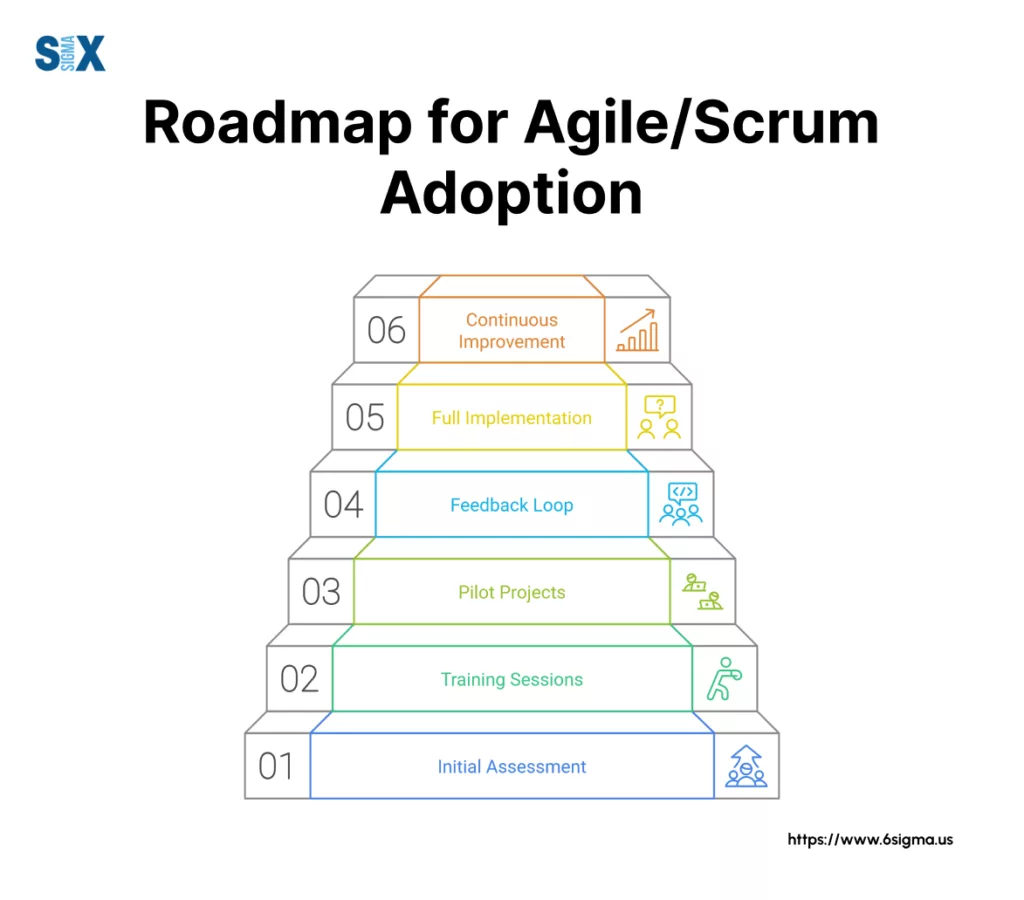
- Assessment: Evaluate current processes and identify areas for improvement
- Education: Provide training on agile vs scrum principles and practices
- Pilot: Implement agile or scrum on a small scale with a receptive team
- Feedback: Gather insights and refine the approach based on pilot results
- Scale: Gradually expand adoption across the organization
- Continuous Improvement: Regularly assess and optimize processes
When deciding between scrum vs agile development, remember that both methodologies require commitment and patience.
The key is to align the chosen approach with your organization’s culture and project needs.
By addressing these common challenges and following proven implementation strategies, you can successfully navigate the agile vs scrum difference and leverage these methodologies to enhance your project management practices.
Remember, whether you choose agile or scrum, the goal is to improve project outcomes and deliver value to your customers more efficiently.
With proper planning and execution, the transition to these modern project management approaches can transform your organization’s ability to innovate and adapt in today’s fast-paced business environment.
Make Transformative change with our Black Belt training program
Certifications and Professional Development
In the agile vs scrum project management, professional certifications play a crucial role in validating expertise and advancing careers.
Understanding the landscape of agile vs scrum certification options can help professionals make informed decisions about their career development paths.
Agile Certifications
Popular Agile certifications include:
- PMI Agile Certified Practitioner (PMI-ACP)
- ICAgile Certified Professional (ICP)
- SAFe Agilist (SA)
These certifications demonstrate a broad understanding of agile methodologies and principles.
Scrum Certifications
When it comes to scrum vs agile certification, Scrum offers more role-specific options:
- Certified ScrumMaster (CSM)
- Professional Scrum Master (PSM)
- Certified Scrum Product Owner (CSPO)
Both paths offer valuable insights into modern project management practices and can significantly enhance your professional profile.
Conclusion
In this comprehensive exploration of agile vs scrum, we’ve delved into the key differences, similarities, and applications of these two influential project management approaches.
We’ve seen that while Scrum is a specific framework within the broader Agile philosophy, both share common principles of flexibility, collaboration, and continuous improvement.
The choice between agile methodology vs scrum ultimately depends on your organization’s specific needs, project types, and team dynamics.
Whether you opt for the adaptable principles of Agile or the structured framework of Scrum, both approaches offer powerful tools for enhancing project efficiency and delivery.
As you reflect on your current project management practices, consider how elements of Agile or Scrum could benefit your teams.
Take the time to assess your organization’s readiness for these methodologies and explore the certification options that align with your career goals.
Remember, the journey towards agile or scrum adoption is ongoing. Continual learning, adaptation, and improvement are at the heart of both approaches.
We encourage you to take the next step in your agile vs scrum project management journey – whether that’s further research, training, or initiating a pilot project in your organization.
SixSigma.us offers both Live Virtual classes as well as Online Self-Paced training. Most option includes access to the same great Master Black Belt instructors that teach our World Class in-person sessions. Sign-up today!
Virtual Classroom Training Programs Self-Paced Online Training Programs







